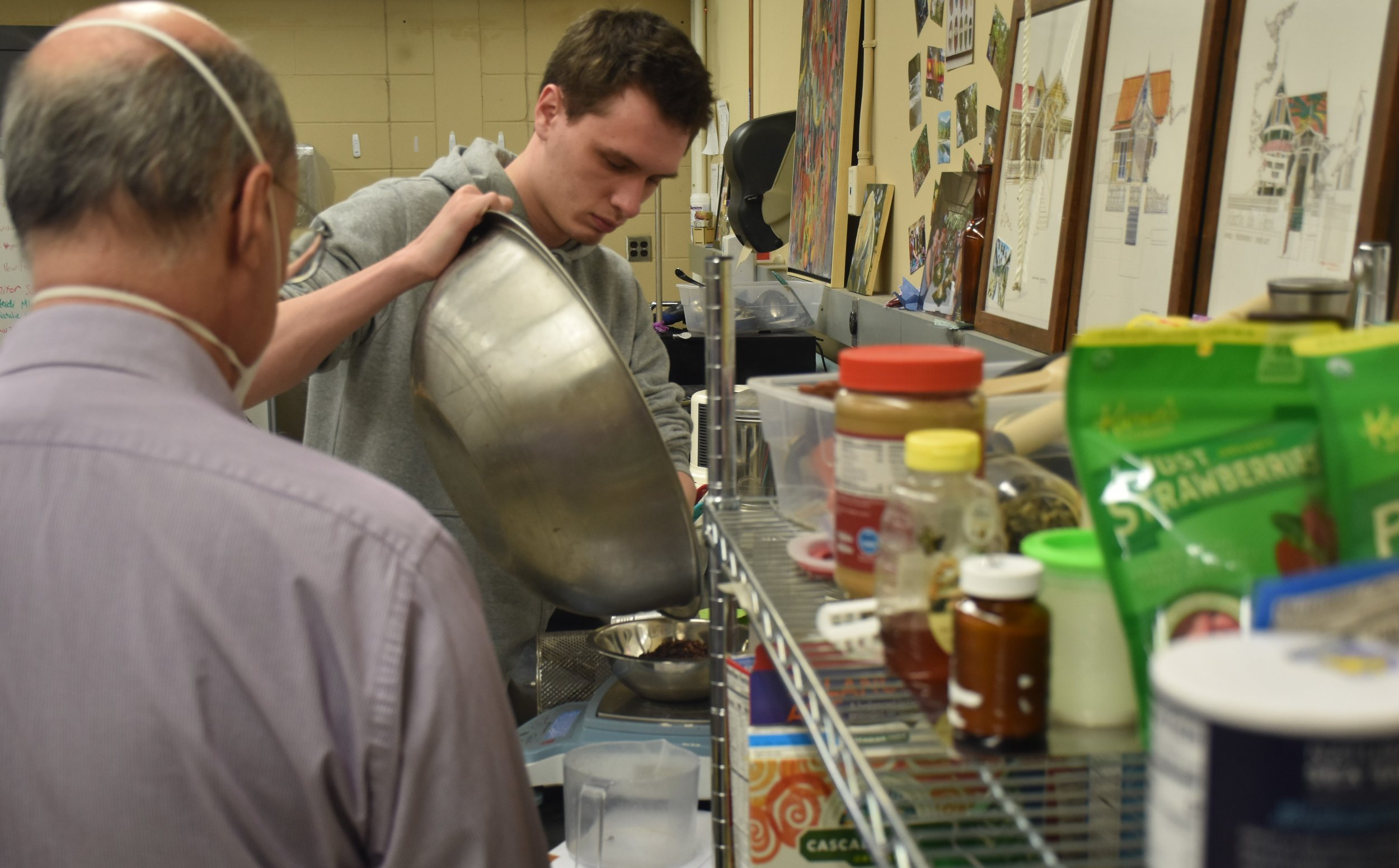From Trinidad to Duluth to Washington: How UMD’s Chocolate Lab is Turning Heads
Engineering 112. In the heart of Swenson, a passerby may be turned away from its industrial facade. Stainless steel bowls resting on stainless steel countertops, machines with stainless steel drums loudly whir with noise. It certainly has that special Swenson quality of looking simultaneously daunting and rather mundane to non-engineer students. But this is one room on campus that manages to make advanced chemical engineering concepts more palatable.
Club member Natalie Watson taking her chocolates out of their molds and bagging them. Photo by Seth Roeser
The UMD Chocolate Club has been hard at work in the lab this year. From experimenting with new recipes to sending confections across the country, as well as inspiring new programs in Washington, the lab has been blazing a trail through uncharted territories while creating quality, ethical artisanal chocolates.
Created in 2017, the Chocolate Club started off as a collaborative effort between Lab Services Coordinator Lyndon Ramrattan and engineering professor Steven Sternberg, PhD. over a shared interest in cocoa tea, which Ramrattan introduced to Sternberg. From there, the two started researching chocolate making.
Ramrattan and Sternberg (far left and far right) talking chocolate in the lab. Photo by Seth Roeser
“I realized this is something that a chemical engineer could do,” Sternberg said.
Inspired, Sternberg wrote a grant titled “Chocolate Across the Curriculum And Outreach” [CACAO] and received funds to buy the necessary equipment.
The lab's chocolate melanger. It is used to refine the chocolate. Chemical engineers may be more familiar with another name for this machine: an edge runner. Photo by Seth Roeser
“[Chocolate] makes it very easy to talk with people about chemical engineering,” Sternberg said.
“Typically, if you tell somebody you’re a chemical engineer, they take two steps back from you and try to figure out how to get away from you as fast as possible.”
Making chocolate “engages all the senses” and turns chemical engineering concepts into concrete, easier-to-understand processes, and Sternberg has found the lab overlaps well with the preexisting curriculum for students.
“It’s sort of an inviting thing,” said Ramrattan. “Let's talk chocolate. Then it's not a scary room anymore, it's fun again.”
Students in the club are encouraged to create their own chocolate recipes. Some chocolates have blueberries, some have Nutella, others have Rice Krispies, but some are more unusual. The club continuously pushes for the unorthodox, utilizing unique ingredients or messing around with the measurements of recipes. Every small detail, including the bean type, is subject to change. Room 112 has cocoa beans from all over the world, ranging from Trinidad to Vietnam.
Lab member Max VanBergen weighing roasted cocoa beans. Photo by Seth Roeser
This experimentation leads to a better understanding of chocolate as a whole.
“We spoil you in a way,” Ramrattan said. “It makes you have a different appreciation for every chocolate bar you’re going to get for the rest of your life. You will never look at chocolate the same way again.”
The chocolate industry is infamous for its treatment of workers, many of whom are children or work without compensation. Because of this, Ramrattan and Sternberg are dedicated to creating ethically sourced products. The Chocolate Lab only buys cocoa directly from independent cocoa farmers or from UncommonCacao.com, a site that specializes in doing business with ethical producers.
“You’re not just buying a chocolate,” Sternberg said. “You’re supporting these farmers.”
The Chocolate Club is an anomaly in the US, where there are very few university-run chocolate labs — they are more common in European countries such as Switzerland or Belgium. Its oddity, as well as the quality of the lab’s chocolate, has attracted attention from across the country.
While attending the Northwest Chocolate Festival in Seattle, Sternberg connected with Dr. Sarah Williams, a professor at Evergreen State College in Olympia, Washington. After a brief back-and-forth between her and the club, Williams flew to Trinidad and visited the UMD Cocoa Lab at the St. Julien Estate in hopes of starting a study abroad program in the same vein as the “UMD Chocolate in Trinidad” program.
The St. Julien Estate lab was created during the last Trinidad study abroad trip, which was faculty-led by Ramrattan and Sternberg. Students studied and participated in cocoa pod harvesting, bean prep and creating their own chocolates. They also learned about the impact the chocolate industry has on local communities.
As far as Ramrattan and Sternberg are aware, UMD is the only university in the world with a study abroad program about chocolate (for now).
Many groups have visited the lab: local schools, University for Seniors, the Professional Engineering Society and even former UMN president Eric Kaler. Duluth-based restaurants and bakeries, such as Sara’s Table and Wussow’s Concert Cafe, have sampled the lab’s chocolates to compare them with the chocolates they buy commercially.
“We do a little sort of collaborative trade,” Ramrattan said. The club gives out pounds of chocolate and restaurants return with baked goods that use the lab's products.
Thank You bags filled with the club's chocolate. Photo by Seth Roeser
The Chocolate Club has big plans for the future. Sternberg and Ramrattan want to emphasize using local ingredients, such as maple syrup and wild rice, though these recipes haven’t been tested yet. Another chocolate-oriented study abroad trip in Trinidad is planned for December 2023.
Despite its cold industrial facade, Swenson holds a unique oddity in room 112 that hasn’t been imitated yet. More information about the Chocolate Lab can be found on the club’s Instagram page.





